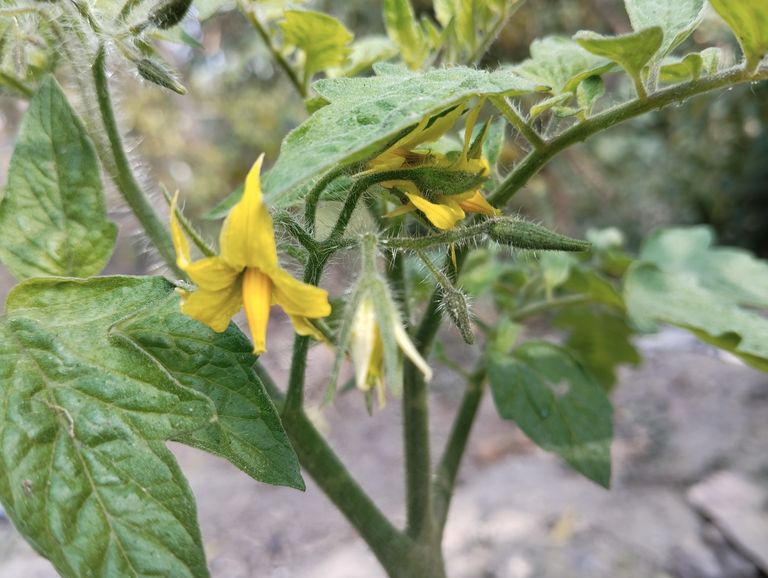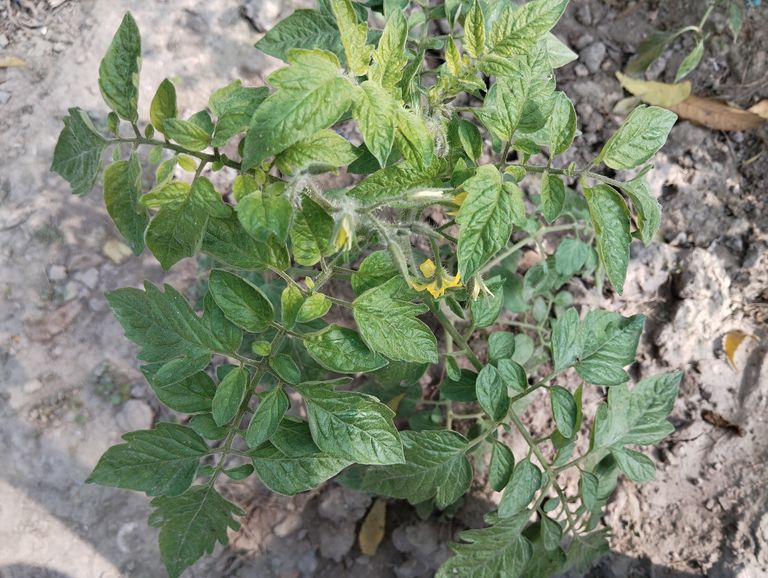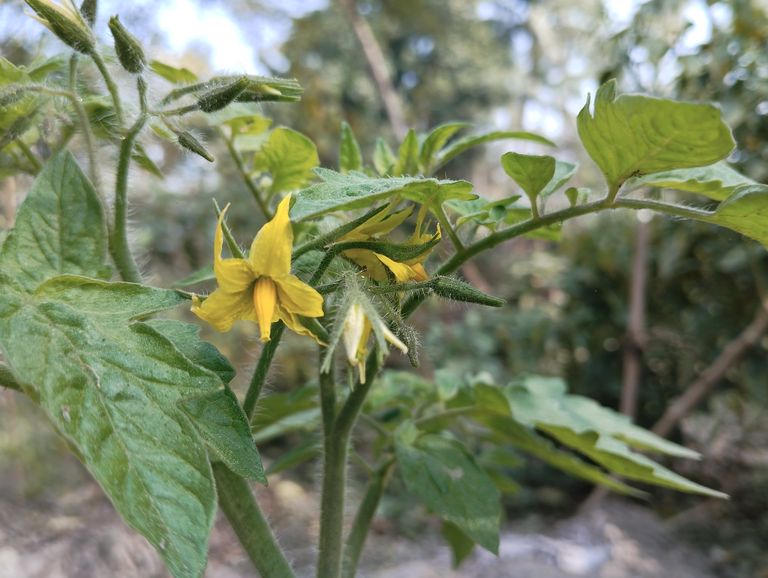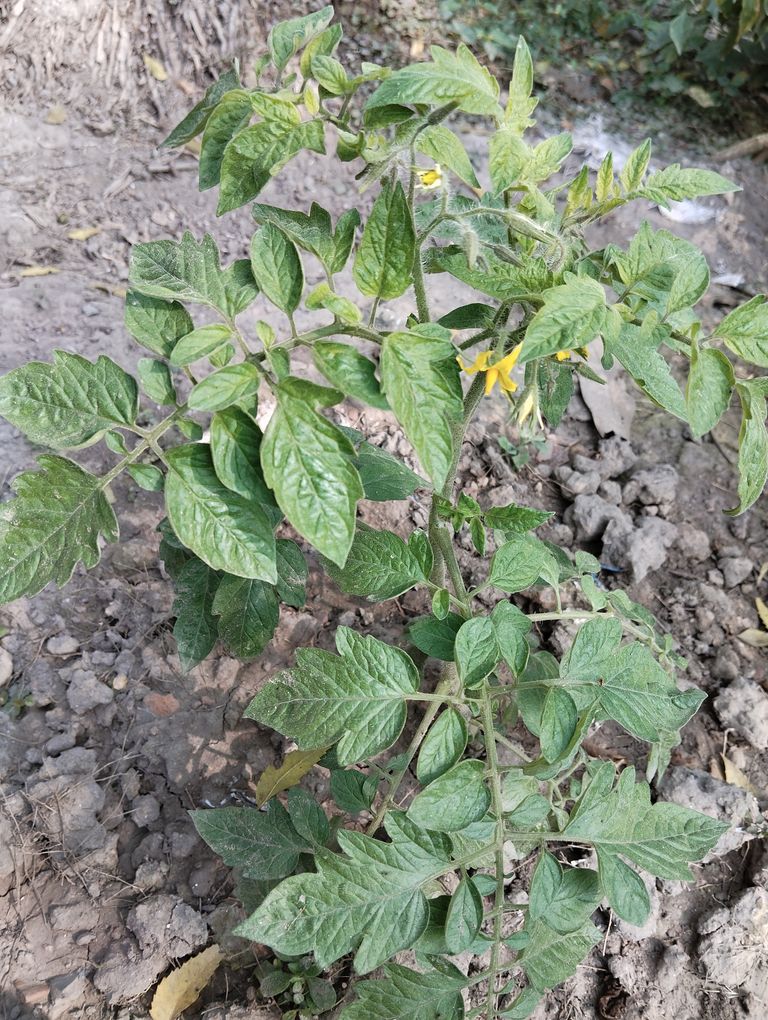
Proper Method of Planting Tomato Seedlings.
Tomatoes are one of the most popular and versatile crops for home gardeners and commercial farmers. Planting tomato seedlings correctly is essential to ensure healthy growth, high yield, and disease resistance. This guide will provide a detailed step-by-step process for planting tomato seedlings effectively.
- Preparing the Soil
Tomatoes thrive in well-drained, fertile soil with a pH level of 6.0 to 6.8.
Location Selection: Choose a sunny location with at least 6-8 hours of direct sunlight daily.
Soil Enrichment: Mix organic compost or well-rotted manure into the soil to improve fertility and drainage. Adding a balanced fertilizer (10-10-10) can also boost nutrient levels.
Testing the Soil: Conduct a soil test to ensure optimal pH and nutrient levels. If the soil is too acidic, lime can be added.
- Choosing Healthy Seedlings
Start with disease-resistant, strong, and healthy seedlings.
Seedling Age: The ideal seedling is 6-8 inches tall and 4-6 weeks old.
Inspection: Check for vibrant green leaves, a thick stem, and no signs of pests or diseases.
- Preparing for Planting
Timing and spacing play a vital role in tomato growth.
Planting Time: Tomatoes should be planted in the late afternoon or on a cloudy day to reduce transplant shock. The temperature should consistently be above 10°C (50°F).
Spacing: Maintain a distance of 18-24 inches between plants and 36-48 inches between rows.
- Planting the Seedlings
Follow these steps to plant the tomato seedlings correctly:
- Digging Holes:
Create a hole deep enough to bury two-thirds of the stem. Burying the stem encourages root growth along the buried part, making the plant more stable.
- Adding Fertilizer:
Place a small amount of balanced fertilizer or compost at the bottom of the hole. Mix it lightly with the soil to prevent direct contact with the roots.
- Planting the Seedling:
Remove the lower leaves from the seedling.
Place the seedling in the hole at an angle to encourage a strong root system.
Cover the stem with soil, leaving the top few leaves exposed.
- Watering:
Water the plant immediately after planting to settle the soil and eliminate air pockets.
- Providing Support
Tomatoes require support to grow upright and prevent fruit from touching the ground.
Staking: Use stakes or bamboo poles placed 6 inches away from the plant. Tie the stem loosely to the stake with soft fabric or gardening ties.
Caging: Tomato cages provide 360-degree support and are ideal for larger varieties.
- Mulching and Watering
Proper moisture and temperature regulation are crucial for tomatoes.
Mulching: Apply a 2-3 inch layer of organic mulch (like straw, grass clippings, or wood chips) around the plant base. This helps retain moisture, suppress weeds, and regulate soil temperature.
Watering:
Water deeply 2-3 times a week, depending on the weather and soil conditions.
Avoid overhead watering; instead, water at the base to reduce the risk of fungal diseases.
- Pest and Disease Management
Regular monitoring and preventive measures are essential.
Common Pests: Aphids, whiteflies, and tomato hornworms are common threats. Use natural predators like ladybugs or apply neem oil to manage pests.
Diseases: Early blight, late blight, and powdery mildew are common fungal issues. Rotate crops yearly and avoid planting tomatoes in the same spot consecutively to reduce disease risks.
- Pruning and Maintenance
Pruning: Remove suckers (small shoots growing between the main stem and branches) to focus energy on fruit production.
Weeding: Regularly remove weeds around the plant to reduce competition for nutrients.
- Harvesting
Tomatoes are typically ready for harvest 60-85 days after planting, depending on the variety.
Harvest when the fruit is firm and fully colored. Gently twist or cut the tomatoes to avoid damaging the plant.

Why Tomato Flowers Fall Off: Causes and Solutions
Tomatoes are one of the most popular vegetables (technically fruits) grown worldwide, but many gardeners face a common issue: the flowers of the tomato plant fall off before setting fruit. This phenomenon, known as “blossom drop,” can be frustrating, especially when you are expecting a good harvest. In this blog, we’ll explore the causes of tomato flower drop and provide effective solutions to address this issue.
Causes of Blossom Drop in Tomato Plants
- Temperature Extremes
Tomato plants are sensitive to temperature fluctuations.
High temperatures: When daytime temperatures exceed 85°F (29°C) and nighttime temperatures remain above 70°F (21°C), the plants become stressed, leading to flower drop.
Low temperatures: Nighttime temperatures below 55°F (13°C) can also hinder pollination, causing flowers to fall off.
- Humidity Levels
Extreme humidity—whether too high or too low—can disrupt the pollination process.
Low humidity dries out the pollen, making it less sticky and ineffective.
High humidity causes pollen to clump together, preventing proper transfer to the stigma.
- Poor Pollination
Tomato flowers are self-pollinating, but they require some movement (like wind or insects) to transfer pollen within the flower. If there’s insufficient wind or a lack of pollinators like bees, flowers may not set fruit and eventually drop.
- Nutrient Imbalances
Excess nitrogen: Over-fertilizing with nitrogen promotes lush foliage at the expense of flower and fruit production.
Deficiency of nutrients: A lack of essential nutrients like phosphorus, potassium, or calcium can also weaken flowers, making them more likely to fall off.
- Water Stress
Inconsistent watering—either too much or too little—stresses the plant. Drought conditions or waterlogged soil can both cause blossom drop.
- Pests and Diseases
Certain pests, such as thrips, aphids, and whiteflies, can damage flowers. Additionally, fungal diseases or bacterial infections can weaken the plant, causing it to shed flowers.
- Excessive Pruning or Handling
Over-pruning or excessive handling of plants can disturb flowers, leading to their drop.
- Varietal Issues
Some tomato varieties are more sensitive to environmental stress than others. Heirloom varieties, for example, may be more prone to flower drop than hybrid ones bred for resilience.
Solutions to Prevent Tomato Flower Drop
- Maintain Optimal Temperature
Use shade cloths or row covers to protect plants from extreme heat.
If growing in cooler climates, consider using a greenhouse or planting cold-tolerant tomato varieties.
- Control Humidity
In dry conditions, mist plants with water to increase humidity.
In overly humid areas, ensure proper air circulation by spacing plants adequately and pruning excess foliage.
- Encourage Pollination
Shake the plants gently or use an electric toothbrush near the flowers to mimic the buzzing of bees and enhance pollination.
Plant flowers nearby that attract pollinators, such as marigolds or lavender.
- Balance Fertilizer Use
Use a balanced fertilizer with lower nitrogen and higher phosphorus and potassium levels (e.g., 5-10-10).
Add calcium to prevent blossom-end rot and strengthen flowers.
- Water Consistently
Water the plants deeply once or twice a week, depending on weather conditions. Avoid letting the soil completely dry out or become waterlogged.
Apply mulch around the base of plants to retain moisture and regulate soil temperature.
- Protect from Pests and Diseases
Inspect plants regularly for pests and use organic insecticides like neem oil if necessary.
Remove any diseased foliage and practice crop rotation to prevent fungal and bacterial diseases.
- Choose the Right Varieties
Opt for heat-tolerant or cold-tolerant tomato varieties based on your region's climate.
Hybrid varieties are often more resilient to environmental stressors.
- Practice Proper Handling
Avoid over-pruning or excessive handling of the plants, especially during flowering.
Support plants with stakes or cages to minimize disturbances.
Blossom drop in tomatoes can be caused by a variety of factors, including environmental stress, nutrient imbalances, and poor pollination. By understanding these causes and implementing the solutions mentioned above, you can create a healthier growing environment for your tomato plants and ensure a bountiful harvest.

How to Plant Tomato Seedlings in Rows: A Comprehensive Guide
Tomatoes are among the most popular vegetables grown by gardeners worldwide. Proper planting techniques are essential for healthy growth and a bountiful harvest. This guide will walk you through the steps to plant tomato seedlings in rows effectively.
Why Row Planting Is Important
Planting tomato seedlings in rows provides:
- Adequate Space: Ensures each plant gets enough room to grow and receive sunlight.
- Proper Air Circulation: Reduces the risk of fungal diseases.
- Ease of Maintenance: Simplifies watering, weeding, and harvesting.
Step-by-Step Guide to Row Planting Tomato Seedlings
- Preparing the Soil
Healthy soil is crucial for tomato growth. Follow these steps:
Choose a sunny spot: Tomatoes require 6-8 hours of direct sunlight daily.
Test the soil: Ensure the pH level is between 6.0 and 7.0.
Enrich the soil: Add organic compost or well-rotted manure to improve fertility.
Loosen the soil: Till the soil to a depth of 12-15 inches for better root penetration.
- Spacing the Rows and Plants
Proper spacing is critical for optimal growth:
Distance between rows: Maintain a gap of 3-4 feet (90-120 cm) between rows.
Spacing between plants: Keep 18-24 inches (45-60 cm) between each plant within the row.
This spacing ensures each plant gets enough room for its roots and canopy to develop.
- Digging Holes for Planting
Hole depth: Dig a hole 6-8 inches deep to bury the lower part of the seedling stem.
Hole width: Make the hole wide enough to accommodate the root ball comfortably.
- Planting the Seedlings
Remove lower leaves: Trim the bottom leaves to bury a portion of the stem. This encourages root growth along the buried stem.
Place the seedling: Position the seedling in the hole at a slight angle if the plant is tall or leggy.
Cover with soil: Fill the hole with soil, pressing gently around the base to secure the plant.
- Watering After Planting
Initial watering: Water the seedlings immediately after planting to settle the soil.
Regular watering: Maintain consistent moisture, but avoid overwatering to prevent root rot.
- Supporting the Plants
Tomato plants need support as they grow taller:
Stakes or cages: Install stakes or tomato cages at planting time to avoid disturbing the roots later.
Tying the plant: Use soft ties to secure the plant to the support structure.
- Mulching the Rows
Benefits of mulching: Retains soil moisture, suppresses weeds, and regulates temperature.
Types of mulch: Use straw, grass clippings, or black plastic mulch around the base of the plants.
- Fertilizing the Plants
Initial fertilization: Mix a balanced fertilizer into the soil before planting.
Ongoing fertilization: Apply a low-nitrogen fertilizer every 2-4 weeks during the growing season.
- Pruning and Maintenance
Remove suckers: Prune the small shoots that grow between the main stem and branches to direct energy to fruit production.
Monitor for pests: Regularly check for signs of pests or diseases and take immediate action if needed.
Planting tomato seedlings in rows is a systematic approach that ensures healthy plants and abundant harvests. By preparing the soil, spacing the plants correctly, and providing proper care, you can enjoy delicious, homegrown tomatoes throughout the season. Follow these steps, and your garden will flourish with vibrant tomato plants.

Here's a detailed 4000-word blog post on tomato recipes in English:
The Ultimate Guide to Tomato Recipes: Fresh, Flavorful, and Healthy
Tomatoes are the heart and soul of countless cuisines around the world. From Italian pastas to Indian curries, this versatile fruit (yes, it's a fruit!) can elevate the simplest of dishes with its tangy, juicy flavor. In this blog, we’ll explore an array of tomato recipes that cater to all taste buds, whether you’re a fan of spicy, savory, or sweet dishes.
Why Tomatoes?
Tomatoes are packed with nutrients like vitamin C, potassium, and antioxidants, particularly lycopene, which is known for its health benefits, including reducing the risk of heart disease and cancer. Their vibrant flavor makes them a staple in both home kitchens and gourmet restaurants.
Tomato Recipes to Try
- Classic Tomato Soup
A warm bowl of tomato soup is the ultimate comfort food.
Ingredients:
6 large ripe tomatoes
1 onion, finely chopped
2 garlic cloves, minced
2 cups vegetable broth
1/2 cup heavy cream (optional)
Salt and pepper to taste
Fresh basil leaves for garnish
Instructions:
- Blanch the tomatoes in boiling water for 1-2 minutes. Peel off the skins.
- Heat olive oil in a pot. Sauté onion and garlic until fragrant.
- Add the tomatoes and cook until soft.
- Pour in the vegetable broth and simmer for 15 minutes.
- Blend the mixture until smooth. Add cream if desired.
- Season with salt and pepper, garnish with basil, and serve with crusty bread.
- Fresh Tomato Salsa
Perfect for dipping or as a topping for tacos.
Ingredients:
4 medium tomatoes, finely chopped
1 small onion, chopped
1 jalapeño, minced
Juice of 1 lime
Handful of fresh cilantro, chopped
Salt to taste
Instructions:
- Combine all the ingredients in a bowl.
- Mix well and let it rest for 10 minutes to allow the flavors to meld.
- Serve with tortilla chips or as a side dish.
- Tomato Basil Pasta
A quick and easy Italian dish.
Ingredients:
400g spaghetti or your choice of pasta
5 large tomatoes, diced
3 garlic cloves, sliced
1/4 cup olive oil
Fresh basil leaves
Salt and pepper to taste
Parmesan cheese (optional)
Instructions:
- Cook the pasta according to package instructions.
- Heat olive oil in a pan. Sauté garlic until golden.
- Add diced tomatoes and cook until they break down into a sauce.
- Season with salt and pepper. Add basil leaves.
- Toss the pasta in the sauce. Serve hot with Parmesan cheese.
- Spicy Tomato Chutney
A delicious condiment that pairs well with rice, bread, or snacks.
Ingredients:
5 medium tomatoes, chopped
1 onion, finely chopped
2 garlic cloves, minced
1-inch ginger, grated
2 dried red chilies
1 tsp mustard seeds
1 tbsp oil
Salt and sugar to taste
Instructions:
- Heat oil in a pan. Add mustard seeds and let them splutter.
- Sauté onion, garlic, ginger, and chilies until golden.
- Add tomatoes, salt, and sugar. Cook until the mixture thickens.
- Store in an airtight container and refrigerate.
- Tomato Salad
A refreshing and healthy side dish.
Ingredients:
3 large tomatoes, sliced
1 cucumber, sliced
1 red onion, thinly sliced
2 tbsp olive oil
1 tbsp balsamic vinegar
Salt and pepper to taste
Fresh parsley or mint leaves for garnish
Instructions:
- Arrange the tomatoes, cucumber, and onion on a plate.
- Drizzle with olive oil and balsamic vinegar.
- Season with salt and pepper. Garnish with parsley or mint.
Pro Tips for Cooking with Tomatoes
- Choose the Right Variety: Use Roma or San Marzano tomatoes for sauces, and cherry or heirloom tomatoes for salads.
- Ripeness Matters: Overripe tomatoes work best for soups and sauces.
- Enhance the Flavor: A pinch of sugar can balance the acidity of tomatoes in cooked dishes.
- Storing Tomatoes: Keep tomatoes at room temperature for better flavor. Refrigeration can make them mealy.
Bonus: Tomato-Based Drinks
Tomato Smoothie
A nutrient-packed drink for a quick breakfast.
Ingredients:
2 ripe tomatoes, chopped
1 carrot, peeled and chopped
1/2 cucumber
Juice of 1 lemon
1/2 tsp honey (optional)
Instructions:
- Blend all the ingredients until smooth.
- Strain if needed. Serve chilled.
Bloody Mary
A classic cocktail for brunch.
Ingredients:
2 cups tomato juice
1/4 cup vodka
1 tbsp lemon juice
1/2 tsp Worcestershire sauce
1/4 tsp Tabasco sauce
Salt and pepper to taste
Celery stick for garnish
Instructions:
- Mix all the ingredients in a shaker.
- Pour over ice in a glass. Garnish with a celery stick.
Tomatoes are a gift from nature, offering endless culinary possibilities. Whether you’re cooking up a hearty soup or whipping up a fresh salad, tomatoes bring vibrant color and flavor to your plate. Try these recipes and let the magic of tomatoes transform your meals.